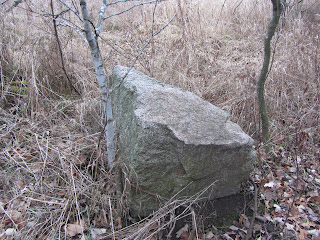Saturday was a good day at Forest Hill for a hike with my dog, Remi. It was nice to be back in familiar surroundings after a two-week absence. The early morning weather was foggy with a temperature of 32 degrees and a mild southerly breeze. Before starting out, I glanced west at the late-autumn landscape. I descended the hill, passed Mallard Marsh and hike through Bobolink Meadow where I heard a pheasant calling out from the underbrush. At the entrance to North Woods. I left the trail and wandered over to a pile of rocks lying on the forest floor, called erratics. Geologists define erratics as stones or boulders that have been carried from their place of origin by a glacier. Next, I returned to the trail, headed south past Willow Wallow and circled Succession Field where I heard a Chickadee in the distance. Also, I spotted some more erratics along the western boundary. When this area was settled, farmers were forced to clear fields of rock obstacles in order to plow and cultivate. Many erratics were used to build fences and foundations, while others were just piled along fencerows or unused field corners. Next, I turned east and left the trail again to examine some more erractics on the north edge of South Woods. The vast majority were igneous or metamorphic rocks, rather than the usual sedimentary rocks that constitute the bedrock of Michigan’s lower peninsula. I noticed a metamorphic rock called granite gneiss and another one with unusual quartz intrusions sticking out. Most glacial erratics appear worn and rounded like this one or beveled like this one. During the course of their journey, the rocks were jostled against other erratics or scraped against the underlying bedrock, rounding off corners and planing smooth surfaces, eventually producing their characteristic appearance. I entered the woods and immediately checked out the raccoon carcass that had not decomposed much in the last two weeks. I walked along the edge of Swanson Swamp and exited the trail once again to check out the largest erratic on the property weighing several tons. Rocks such as this one were transported great distances by the Pleistocene-age glaciers. The most recent, called the Wisconsin stage, retreated from Michigan between 9,500 and 15,000 years ago. I exited the woods, passed Artist Overlook and continued south along Sora Swale where I observed a large igneous rock called granite lying along the edge of South Woods. Following the south trail to Frog Fen, I turned north to climb Reflection Hill where I gazed down at Grebe Pond shrouded in fog. Descending the hill, I passed the Classroom Building. Finally, we made it to the van and left for home.
Birches are bare silhouettes in the air
the frost is so cold that it burns
a spider web's gold in the sun’s pale glare
asleep until Summer returns.
Jackets of white that have formed in the night
the air is a shock to the lungs
the tinkling mock of the fresh stalactites
as sharp as a rapier’s tongue.
Cuddled up under a star-strewn wonder
the firelight glows flickering flames
and buried below, Summer’s blossoms in slumber
awaiting till Spring calls their names.
The leaves drifting soundlessly float to the ground
quite like boats on a to and fro sea
the multi-hued coat that is woven around
whispers “Winter is Coming” to me.
Unknown

No comments:
Post a Comment